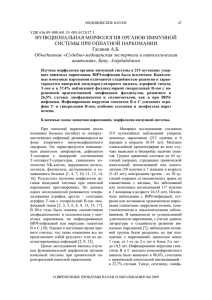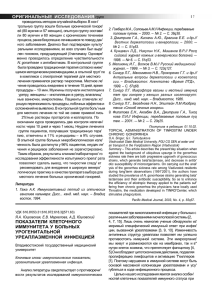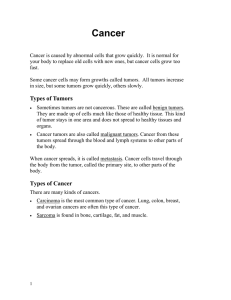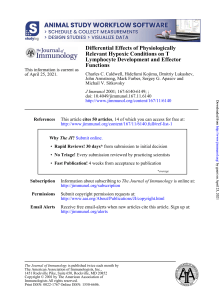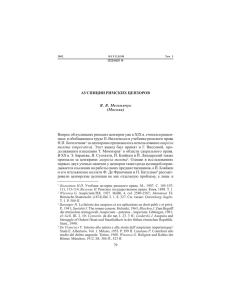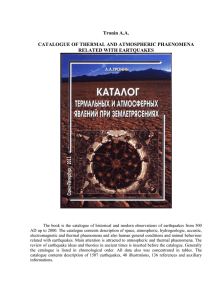Inhibition of T lymphocytes nonspecific proliferation by myeloid derived suppressor cells
реклама
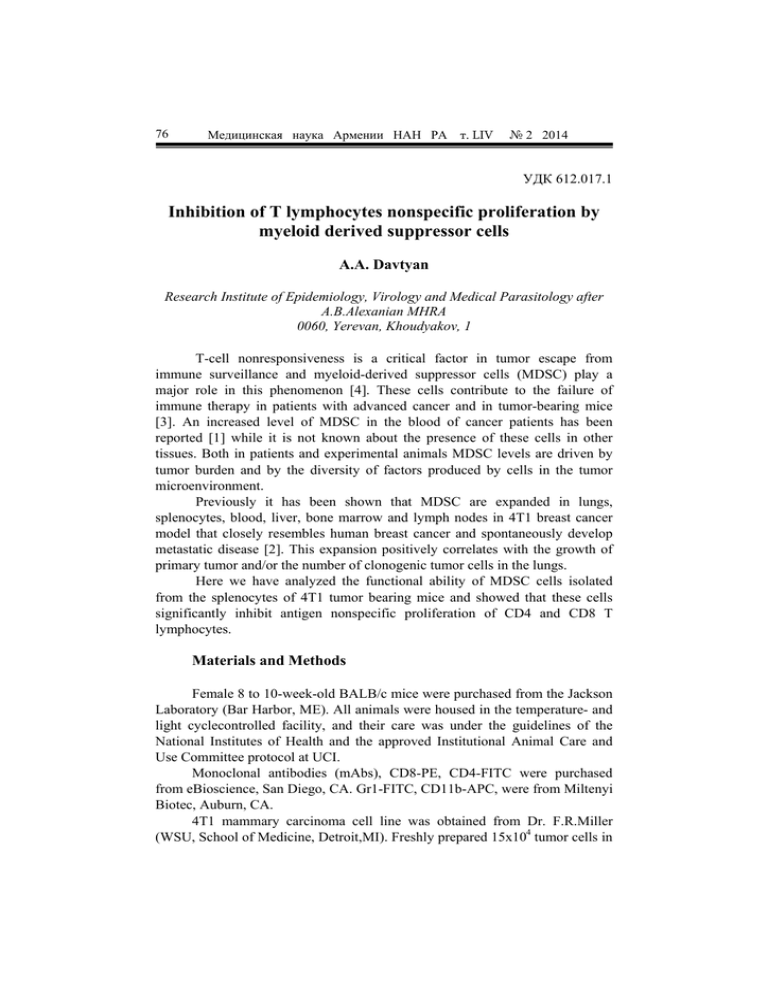
76 Медицинская наука Армении НАН РА т. LIV 1 2 2014 УДК 612.017.1 Inhibition of T lymphocytes nonspecific proliferation by myeloid derived suppressor cells A.A. Davtyan Research Institute of Epidemiology, Virology and Medical Parasitology after A.B.Alexanian MHRA 0060, Yerevan, Khoudyakov, 1 T-cell nonresponsiveness is a critical factor in tumor escape from immune surveillance and myeloid-derived suppressor cells (MDSC) play a major role in this phenomenon [4]. These cells contribute to the failure of immune therapy in patients with advanced cancer and in tumor-bearing mice [3]. An increased level of MDSC in the blood of cancer patients has been reported [1] while it is not known about the presence of these cells in other tissues. Both in patients and experimental animals MDSC levels are driven by tumor burden and by the diversity of factors produced by cells in the tumor microenvironment. Previously it has been shown that MDSC are expanded in lungs, splenocytes, blood, liver, bone marrow and lymph nodes in 4T1 breast cancer model that closely resembles human breast cancer and spontaneously develop metastatic disease [2]. This expansion positively correlates with the growth of primary tumor and/or the number of clonogenic tumor cells in the lungs. Here we have analyzed the functional ability of MDSC cells isolated from the splenocytes of 4T1 tumor bearing mice and showed that these cells significantly inhibit antigen nonspecific proliferation of CD4 and CD8 T lymphocytes. Materials and Methods Female 8 to 10-week-old BALB/c mice were purchased from the Jackson Laboratory (Bar Harbor, ME). All animals were housed in the temperature- and light cyclecontrolled facility, and their care was under the guidelines of the National Institutes of Health and the approved Institutional Animal Care and Use Committee protocol at UCI. Monoclonal antibodies (mAbs), CD8-PE, CD4-FITC were purchased from eBioscience, San Diego, CA. Gr1-FITC, CD11b-APC, were from Miltenyi Biotec, Auburn, CA. 4T1 mammary carcinoma cell line was obtained from Dr. F.R.Miller (WSU, School of Medicine, Detroit,MI). Freshly prepared 15x104 tumor cells in Медицинская наука Армении НАН РА т. LIV 77 1 2 2014 mid-log growth phase were injected into the mammary fat pads [2]. MDSC were isolated from spleens of tumor-bearing mice using the mouse MDSC isolation kit, according to the manufacturer's protocol (Miltenyi Biotec, Auburn, CA, USA). The purity of cell populations was above 90% On day 0 single cell suspension of splenocytes was stained with 5µM CFSE (Carboxyfluorescein succinimidyl ester) dye and cultured in 96-well round-bottom plates in complete culture medium containing plate-bound, antiCD3 (1 µg/ml) and soluble anti-CD28 (5 µg/ml) in the presence or absence of MDSCs . These cell mixtures were cocultured for 72 h at 37°C in 5% CO2. On day 3 cells were harvested and stained with Vioblue CD4, PE-CD8 antibodies. Stained cells were analyzed with MacsQuant cytometer (Miltenyi Biotec, Auburn, CA) Results and Discussion MDSC were isolated by positive selection, using GR1+ magnetic beads. Spleen mononuclear cell suspension was stained with MDSC `s markers. Before isolation the percent of MDSC in splenocytes was 12% , after purification it reached to 90% (fig.1A and B). Isolated MDSC were used for T cells proliferation inhibiton test. A B Fig.1. Purification of MDSC from splenocytes Naïve Balb/c mice splenocytes were stained with CFSE dye and stimulated with or without CD3CD28 antibodies cocktail in the presence or absence of different number of MDSC. After 3 days of incubation, cells were harvested and stained with T cell markers for evaluating proliferation. In control sample (without MDSC) percent of divided CD4 cells was near 37%, percent of CD8 cells was 10%. (fig. 2 and 3). 78 Медицинская наука Армении НАН РА т. LIV 1 2 2014 Fig. 2. Proliferation of CD4 cells Fig. 3. Proliferation of CD8 cells Adding MDSC to the splenocytes culture in 1:4 ratio dramatically decreased proliferation percent of CD4 and CD8 cells, respectively to 10% and 2%. Furthermore, presence of MDSC cells in 1:1 ratio decreased proliferation percent of CD4 cells to 3% and CD8 cells to 0.5%. The obtained data demonstate that MDSC are potent inhibitors of CD4 and CD8 lymphocytes non specific proliferation. These data are coincident with the results obtained by other groups on different animal models and human MDSC suppressing not only antigen non specific CD3CD28 proliferation, but also antigen specific proliferation of CD4, CD8 cells [5}]. MDSC cause immune suppression in most cancer patients, where they are an impediment to all immunotherapies that require an active immune response by the host and elimination of MDSC is a priority for cancer patients who are candidates for active immunotherapy. Поступила 16.05.14 Медицинская наука Армении НАН РА т. LIV 1 2 2014 79 T-լիմֆոցիտների ոչ սպեցիֆիկ պրոլիֆերացիայի ինհիբիցիան միելոիդային սուպրեսոր ակտիվությամբ բջիջների կողմից Ա.Ա. Դավթյան T-բջիջների անպատասխանելիությունը սկզբունքային նշանակություն ունի ուռուցքի իմուն համակարգի հսկողությունից խուսափելու հարցում և միելոիդային սուպրեսորային ակտիվությամբ բջիջները (MDSC) առանցքային դեր ունեն այդ գործընթացում: Քաղցկեղով հիվանդների մոտ ցույց է տրված MDSC-ի քանակի բարձրացում արյան մեջ, ինչը կապված է ուռուցքի առկայությամբ և վերջինիս միկրոմիջավայրում գտնվող բջիջների կողմից արտադրվող բազմաթիվ գործոններով: MDSC-ի առկայությամբ է պայմանավորված բազմաթիվ իմունաթերապևտիկ ստրատեգիաների ձախողումը ինչպես նախակլինիկական, այնպես էլ կլինիկական փուլում: Մկան կրծքագեղձի քաղցկեղի 4Թ1 մոդելի վրա ցույց է տրված MDSC-ի քանակի կտրուկ բարձրացում ամբողջ օրգանիզմում` մասնավորապես թոքերում, լյարդում, փայծաղում, ոսկրածուծում, արյան մեջ և ավշային հանգույցներում: Վերջիններիս քանակի բարձրացումը ամենատարբեր օրգաններում ուղղակիորեն փոխկապակցված է ուռուցքի չափերի կամ մետաստազների քանակի հետ: Այս աշխատանքի մեջ ուռուցքակիր մկների փայծաղից անջատված MDSC-ի վրա հետազոտել ենք վերջիններիս գործառնական ունակությունը` ճնշել CD4 և CD8 լիմֆոցիտների հակագեն ոչ սպեցիֆիկ պրոլիֆերացիան: Ингибиция неспецифической пролиферации лимфоцитов миелоидными супрессорными клетками А.А. Давтян Т-клеточная толерантность является критическим фактором для обхода опухоли от иммунного ответа, и в осуществлении этого феномена миелоидные супрессорные клетки (MDSC) играют ведущую роль. Неудачи в иммунотерапии y пациентов с прогрессирующей опухолью и у мышей, имеющих опухоль, связаны с этими клетками. Было показано, что уровень MDSC повышается в крови у раковых больных. Как у пациентов, так и в экспериментальных животных моделях уровень MDSC обусловлен степенью отягощенности опухолью и разнообразными факторами, продуцированными клетками, находящимися в микроокружении опухоли. 80 Медицинская наука Армении НАН РА т. LIV 1 2 2014 На 4T1 мышиной модели рака молочной железы было показано повышение уровня MDSC в легких, печеночных клетках, крови, костном мозге и лимфатических узлах.Такая экспансия прямо коррелирует с ростом первичной опухоли и/или с количеством колониеобразующих опухолевых клеток в различных органах. В этой работе мы показали, что миелоидные супрессорные клетки, выделенные из печеночных клеток мышей с опухолью, ингибируют антиген-неспецифическую пролиферацию CD4 и CD8 Т лимфоцитов. References 1. Diaz-Montero C., Salem М., Nishimura I., et al. Increased circulating myeloid-derived suppressor cells correlate with clinical cancer stage, metastatic tumor burden, and doxorubicin-cyclophosphamide chemotherapy. Cancer Immunol. Immunother., 2009, 58(1):49-59. 2. Ghochikyan A., Davtyan A., Hovakimyan A. et al. Primary 4T1 tumor resection provides critical ‘‘window of opportunity’’ for immunotherapy. Clin. Exp. Metastasis., 2014, 31(2):185-98. 3. Kusmartsev S., Srinivas Nagaraj and Dmitry I.Gabrilovich Tumor-Associated CD8+ T Cell Tolerance Induced by Bone Marrow-Derived Immature Myeloid Cells. J Immunol., 2005; 175(7): 4583–4592. 4. Nagaraj S., Gupta K., Pisarev V. et al., Altered recognition of antigen is a mechanism of CD8+ T cell tolerance in cancer. Nat. Med., 2007; 13(7): 828–835. 5. Ostrand-Rosenberg S., Sinha P. Myeloid-Derived Suppressor Cells: Linking Inflammation and Cancer. J. Immunol., 2009 ;182(8):4499-506.
